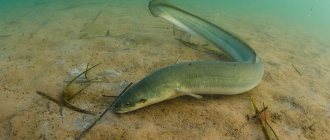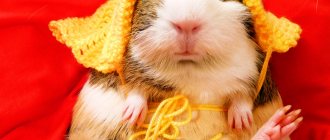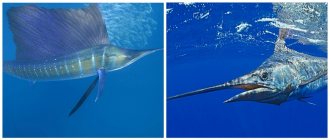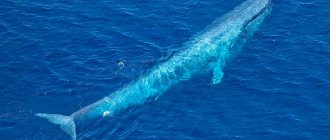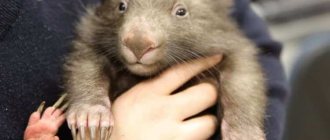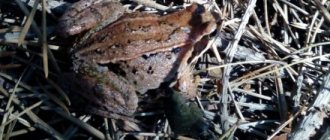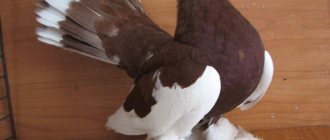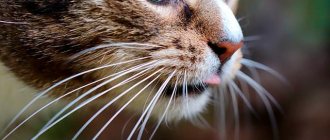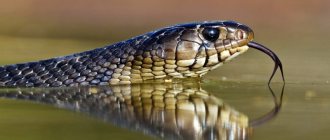A unique and unusual inhabitant of tropical waters, the seahorse is of interest not only to scientists. It lives in water, breathes through gills and has many features. It swims, eats and reproduces differently than most known fish.
| Full name | Seahorses/Hippocampus |
| Kinds | Rainbow, Black Sea, Deciduous, Weed, etc. |
| Colors | Yellow, red, burgundy, blue, multi-colored |
| Water | Salinity – 1022, pH – 8.1-8.3, t – 21°C. |
| Feed | Shrimp, dry food |
| Compatibility | Snails, hermit crabs, blennies |
| Lifespan | 3−5 years |
Description and features of life
Seahorses are fish. They belong to the animal kingdom (class of Ray-finned fish). Long-term studies have shown that seahorses are relatives of pipefish. These are small animals, in most cases reaching a size of up to 24 cm in length. They have a very interesting body shape, reminiscent of a horse. This is where its name comes from. They can change their color like chameleons.
Important! There is information about more than 35 species of seahorses.
Habitat
Most often, seahorses can be found in tropical and subtropical zones. But there are species that prefer to live near the English south coast, in the Mediterranean and Black Seas, as well as near Australia.
Anatomy
The body of a seahorse is covered with a hard shell, necessary for protection. There are also spikes of different shapes and lengths. He has no scales. Skates cannot turn their heads due to the special structure of their skeleton. Therefore, in order to turn around, they turn their entire body or bulge their eyes greatly.
But these are not all the features of the anatomy of seahorses. They are able to move each eye individually. Only chameleons have this ability. In this case, the eyes can rotate 300 degrees. The sea horse swims vertically in the water, but not only straight, but also up or down. This is facilitated not only by the size of the seahorse, but also by the swim bladder, separated by a septum.
Important! If the swim bladder is damaged, the animal sinks to the bottom and dies over a long period of time.
They swim very funny, fluttering their tiny fins. Typically, skates swim short distances from one support point to another. In addition to the swim bladder, these fish maintain their balance with the help of internal ears located in the skull. They are also responsible for orienting the seahorse in the water.
They have an excellent sense of smell thanks to a special organ located under the eyes. The seahorse's nose is a strip with two nostrils. They communicate with each other using special sounds that resemble clicks. They make these noises by rubbing their heads against their outer shell. This is how the fish notify each other of danger.
Character and lifestyle
Seahorses are quite lazy by nature. They move slowly, swimming no more than 150 m in an hour. They are predators, but not aggressive. Most of the time they prefer to cling to corals or algae and hang motionless.
It’s interesting that most skaters are monogamous. They create one couple and are faithful to each other all their lives. If one of the pair dies, the surviving horse stops eating, loses interest in breeding, and soon also dies. Therefore, you cannot take them from their natural habitat and put them in an aquarium. For this purpose, there are specially bred seahorses that are accustomed to living in such conditions.
Social structure
It is extremely rare for a seahorse to live in a school. It is common to see several pairs of individuals living together. But even in this case, an individual can easily change flocks. But most often they swim together, almost never changing partners.
Natural enemies
The habitat of seahorses is shallow water. Therefore, humans pose a special threat to them, and not other, larger predators. It's not just fishing or pollution, although fishing and, in particular, shrimping has greatly reduced the population of skates. In Eastern medicine, seahorses are used to create a huge number of medicines. More than 150 million fish are caught annually for this purpose. They are also considered a delicacy.
Pipit fry love to eat shrimp. But even large fish do not eat adults - they cannot digest their hard shell. This is confirmed by the remains of undigested seahorses, sometimes found in the stomachs of dolphins or sharks.
Important! Only a sand crab can eat a seahorse, the acidity of its stomach can dissolve its hard shell.
Natural diet
The seahorse feeds by eating mainly branchial crustaceans. In a day, a seahorse can eat about 3 thousand of these crustaceans. This is influenced by a very fast digestive process and the absence of a stomach, forcing him to look for food almost all the time. The seahorse's mouth in the form of a long tube makes it possible to eat not only carnivorous food, but also plant food.
House conditions
To introduce animals into an already formed ecosystem, you need to take into account many factors:
- Skates require vertical space, so it is worth purchasing a new aquarium for them with a container height of more than 45 cm.
- The water temperature should be +17.7 °C…+25.5 °C depending on the type. The recommended water acidity is 8.1-8.3 pH, and the density is 1.021-1.024. The presence of phosphates and ammonia is unacceptable. Nitrate levels should not exceed 10 ppm. At least 2 times every 30 days you need to replace ¼ of the water in the aquarium.
- To maintain the conditions necessary for skates, high-quality filtration is required. It is better to use skimmers: they saturate the water with oxygen, but do not create a strong current that can become an obstacle to the normal movement of skates.
- Fish require dim lighting.
- In the aquarium you need to plant plants that produce long leaves. The algae Caulerpa prolifera is often used for landscaping. It grows quickly, creating labyrinths that become a home for fish. Additionally, you can install artificial corals and stands to which the animals will cling with their tails.
Types of seahorses
There are several dozen species of seahorses and each of them has its own characteristics. Most of them are very rare due to rapid population decline.
Spotted
This type of fish is also called yellow. It lives in the waters of India, Pakistan, Japan, and Hawaii. Spotted skates can grow up to 30 cm. The color can be not only yellow, but also brown or reddish-brown. But there are always small dark spots on the body.
Representatives of this species tolerate desalination of water well. They can often be found far from the shore at a depth of 10 m. Suitable for breeding in an aquarium - they are quite unpretentious fish. They coexist well with other representatives of their species.
Rainbow
These incredible fish look very bright and colorful. Their shell takes on all the colors of the rainbow - which makes them visible to predators. Otherwise, rainbow seahorses are no different from their relatives. In addition, they look very attractive in a home aquarium.
Foliar
The leafy sea dragon is related to seahorses. It got its name because of its unusual appearance - its entire body is covered with “leaves” that allow it to hide in algae. This natural miracle is found exclusively near the Australian coast. Therefore, leafy sea dragons are most often encountered by local divers.
Like its relative the seahorse, the dragon is rather slow. It swims only using its dorsal and pectoral fins. Despite its cute appearance, it is a 100% predator (but can also eat plant foods). Natural camouflage allows it to hunt shrimp and small fish. It sucks up its prey using its toothless mouth.
Important! If there is no live prey, the leafy sea dragon can survive for a time by eating algae and other plants.
Unlike male seahorses, dragons do not have a special anterior pouch for carrying their young. Therefore, they place the eggs under their tail. Another difference from its relatives is the inability to cling to algae with its tail. Therefore, leafy sea dragons often die during storms.
Weedy
A very interesting species of seahorse. Weedy sea dragons are close relatives of deciduous ones. They have a similar body structure. But weed dragons have only a few leafy appendages on their bodies, making them virtually indistinguishable from trash on the bottom of the sea.
Important! Weedy sea dragons are on the verge of extinction.
Barbed
It lives off the coast of East Africa and New Guinea, as well as near the Great Barrier Reef. This unusual creature of nature reaches 15 cm in length. Its main characteristic feature is the presence of thorns throughout its body. They are necessary for protection. The spiny seahorse has an interesting coloration that makes it invisible in its natural habitat.
Otherwise, it is not much different from its relatives. Everything related to nutrition or reproduction remains unchanged. In addition, the spiny seahorse is listed in the Red Book as a very rare and endangered species of these fish. Their population is affected by fishing, sea pollution and the use of skates in oriental medicine.
Black Sea
The description of the Black Sea seahorse is not much different from the description of most species of these sea inhabitants. They swim, feed and reproduce just like the rest. They are found not only in the Black Sea, but also in the Mediterranean, Azov, and Atlantic seas. They are occasionally found near the African coast.
Black Sea seahorses live in small groups (up to 10 individuals). As a rule, they make a mate for life. Their population has also declined significantly due to human activity.
Pot-bellied
This is one of the largest species of seahorses. The length of an adult individual reaches 35 cm. The natural environment of amazing pot-bellied seahorses is the waters of Australia and New Zealand. Individual representatives of the species are also found in other seas, but this is extremely rare.
The bellied pipit has a rather long nose and its head is slightly tilted forward. This distinguishes it from many of its relatives, whose heads are held straight. The front of the abdomen protrudes forward, but in general the entire body is narrow. The tail is slightly more curved than other breeds. However, it feeds and reproduces in a way that is natural for all skates.
Neighbors in the aquarium
Next door you can place calm fish or invertebrates in the aquarium. The fish should be small, slow and careful. Ideal neighbors for seahorses would be blennies and gobies. They get along well with a snail, which does not sting corals and cleans the aquarium perfectly. You can also consider living stones as inhabitants of the “house” of needle-shaped fish. These are small pieces of limestone that have been in warm tropical waters for some time and are inhabited by various living organisms. All new neighbors must be healthy to avoid infecting the seahorses.
If you read reviews about seahorse breeding, people write that for two pairs of these fish you need an aquarium volume of 150 liters.
Reproduction
Seahorses are truly unique creatures. In addition to devotion to their partner, they have other reproductive features.
Differences between males and females
It’s no secret that the male bears the responsibility for bearing and giving birth to seahorses’ offspring. These fish are designed in such a way that the female does not have the opportunity to bear children - her body is completely enclosed in a protective shell. But the male has a place in the lower part of the body that is not protected by the shell.
Formation of a couple
Seahorses form a pair after the first mating and the appearance of offspring. Subsequently, they reproduce almost constantly. Skates rarely change their partners.
Mating season and the appearance of offspring
Despite their lazy lifestyle, seahorses take the birth of their young quite seriously. It all starts with the so-called mating games. First, the male and female wrap their tails around each other and circle around like this for several days. This peculiar mating dance ultimately ends in mating.
During the process, the male opens his leathery pocket located in the unprotected lower part of the body. The female, pressing tightly against him, throws several eggs there. This ritual among seahorses continues until the male’s pocket is full. It usually holds up to 600 eggs.
When the pocket fills, the inside becomes like a sponge. This is necessary to feed the eggs. Then the future father, his pocket bulging, sails off to bear his offspring. Babies appear after 1-1.5 months.
Seahorses giving birth are an extraordinary spectacle, but the process itself is very difficult for the male. Until all the babies are born, the end hangs upside down, catching on the algae with its tail. Often the birth of cubs is accompanied by incredibly strong contractions, which the male cannot withstand and dies. Helpless offspring also die with it.
If all is well, then the fish pipit sinks to the bottom and rests there for a long time. The father's responsibilities include not only the birth of offspring, but also their protection until the cubs become independent. This happens after 5 months. Then the offspring swims away, leaving the father forever. Each sexually mature female is capable of laying several tens of thousands of eggs during her life.
Experiment
One day scientists conducted an experiment. A pair of males and a pair of females were placed in one aquarium to breed seahorses. After all the traditional courtship, the female laid her eggs to one of the males for further fertilization. The fertilized male was removed to a nearby aquarium. The remaining male tried to court this female, but all his efforts were in vain. She did not pay attention to him and did not try to lay eggs in his pouch. When they finally returned the male back to the aquarium with the female, she again chose him to fertilize her offspring. So he was removed again and again after the eggs were placed on him. Despite the fact that the second male continued to court her, the female seahorse still chose her previous male to reproduce. The experiment with fish was done 6 times - everything remained unchanged.
What to do: the fish float to the surface
Condorita
They don't have enough oxygen. Are there any plants in the aquarium? Be sure to plant it. By the way, you started the fish early. First, it was necessary for the plants to take root properly. Throw in a couple of snails - they purify the water. And, of course, buy a device to enrich the water with oxygen.
Chingachgook the Green Snake
I had this happen. Your plants are blooming, which is why the water is cloudy. And plants can also consume oxygen rather than produce it if there is little light or under other unusual conditions. Change the water and plant other plants. And rinse the soil thoroughly under running water.
Irina
I would not recommend changing all the water, change 1/3 of the total volume (the so-called water change), before this the water should sit for at least a day in a glass jar, I usually add 0.5 tsp to the water (per 3 liters). large cook, salt) - for prevention. The water is cloudy from excess decomposing food - there are a lot of ciliates in the aquarium - a salted solution will help, unless of course the fish are completely sick, and the aquarium should not be in direct sunlight.
Lelka
After filling the aquarium and replanting the plants, you need to wait 5 days: believe me, no air conditioner (even the Tetra Aquasafe Start) will immediately make the water suitable for settling fish. Place the fish in jars with SETTENED water, replace the water in the aquarium by 1/3 and wait 5 days; plants and snails, in principle, can and should even be left. Just connect spray bottles to the jars to force air out. But there are a lot of fish, we have 75 liters, live lalius, tarakatum, labeo and crayfish, + 3 ampoules and reels. Ancistrus and speckled catfish are waiting their turn after quarantine for replanting. But the telescope and the veiltail live separately. They grow very large.
Elena Gabrielyan
You initially equipped the aquarium incorrectly. The first stage: the aquarium is installed, the soil is thoroughly washed, water is added, all equipment is installed (filter, water heater - the filter power should be 800 L/hour, ask the seller) and left for 7-10 days without planting fish . After 10 days, plants are planted, the water temperature in the aquarium is checked and adjusted if necessary. Stage 2: planting. (depending on taste) and aquarium decoration. During this time, the water may turn white - this is normal. As soon as the plants adapt and begin to grow, the water will clear itself. Conditioner is added to the aquarium to speed up water preparation, but does not replace the biological processes associated with the beginning of the functioning of the aquarium. During the time of proper arrangement of the aquarium, if possible, you need to transfer the fish to an already prepared aquarium. and remake yours. The aquarium is being prepared for occupancy within a month. there is no hurry. The fish float to the surface because the water is not ready; a sudden change in the chemical composition can lead to the death of the fish in a very short time. Scaries and telescopes are not compatible with each other. Goldfish are kept separately from everyone else. You can’t plant living plants with them either; while digging in the soil, they will break them and partially eat them. Do not overfeed your fish with dry food. The water can become cloudy because you give it too much, they don’t have time to eat it and the rhv, decomposing at the bottom, sweats the water, hence the unpleasant smell in the aquarium. You can try to purify the water, purchase a water purification conditioner from a specialized store and add it to the aquarium. BEFORE use, read the instructions or ask a qualified specialist how to use it correctly. I wish you success in this hobby.
Victoria
It is recommended to stand tap water for a period of time. 3 days, but you can speed up the preparation process - heat the water to 50-60 degrees (do not boil!) and let it stand for at least 5-6 hours - you can pour it into the aquarium. Proven by many years of experience!
Video seville pseudoscat
It must be said that various species of fish of the Balitoridae family feed in captivity not only on bacterial mucus and algae. In addition to dry food - flakes and tablets - they happily eat ice cream, or rather freshly thawed zooplankton. And according to Vadim Arbuzenko, they also actively gobble up well-washed tubifex, frozen small bloodworms and happily gnaw on pieces of lean fish or balls of minced shrimp meat. The main condition for successful feeding “without negative consequences”: a single portion should be eaten without any residue within 3-5 minutes.
Of course, in the general aquarium, balitorids have more than enough assistants in this matter. And given the small size of the Seville (about 5 cm for the male and 3-4 cm for the female), as well as their peaceful disposition, it is better for them to choose the most friendly and calm neighbors, who are also not large. Of the mobile species, use small characins, cardinals and various medium-sized rasboras. Among labyrinths, for example, lalius or small gourami are quite suitable. To revitalize the bottom area, purchase corydoras and acanthophthalmus. If a container with a similar population does not seem bright enough to you, add more small livebearers there.
In general, in an aquarium with small, peace-loving fish that do not grow more than 5 cm, Seville pseudoscts, and gastromyzonoids in general, feel much more comfortable than with peaceful, but large, or small, but territorial fish. The fast-moving Seville gets along with both, but due to some constantly present stress, they do not fully develop. In an aquarium with live plants, you can see how fish not only move along its walls, but also funny, like a monkey, jumping from branch to branch, that is, from leaf to leaf.
Photo of Seville pseudoscat
You can tirelessly watch the behavior of Seville for hours. Having a ventral sucker formed by modified pectoral and pelvic fins, fish easily move along a vertical surface, and it seems that their entire life is spent in continuous movement.
Especially funny are the funny twitching dances of fish and their mating games. Having taken a fancy to the “lady,” the male begins his galloping dance around her. At the same time, the suitor’s pelvic fins twitch in a peculiar way, creating the impression that the fish is spurring itself to take active action.
Of course, I did not think about propagating Seville, believing that this was a particularly troublesome matter, associated with the preparation of “tricky” water and other labor-intensive preparatory work. In addition, having spent my entire aquarium life studying African cichlids and cichlids in general, I did not understand at all how to approach such fish.
I didn’t look for ways of breeding, but decided to draw the attention of my friend and lover of trying to achieve the impossible from various fish, Vadim Arbuzenko, to the Seville fish. And as it turned out, I was late. By that time, Vadim had managed not only to become interested in striped Sevilles, but also to get offspring from them
By that time, Vadim had managed not only to become interested in striped Sevilles, but also to get offspring from them.
